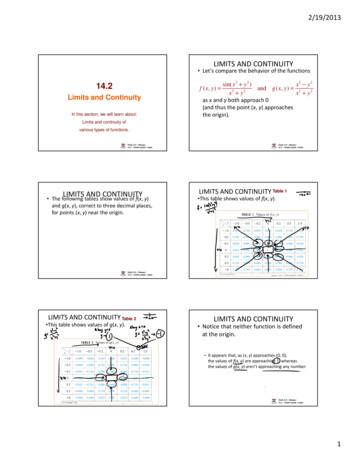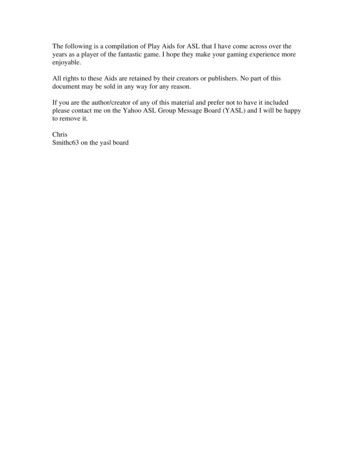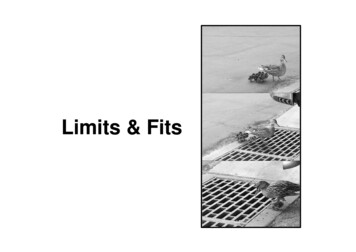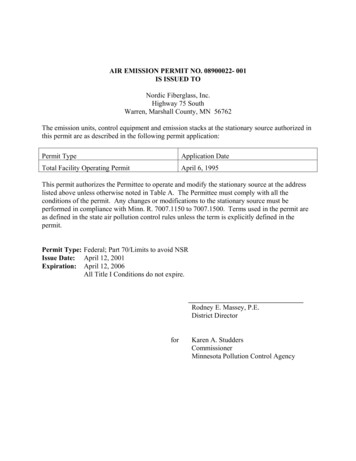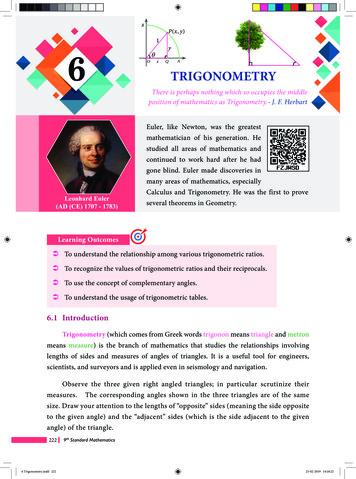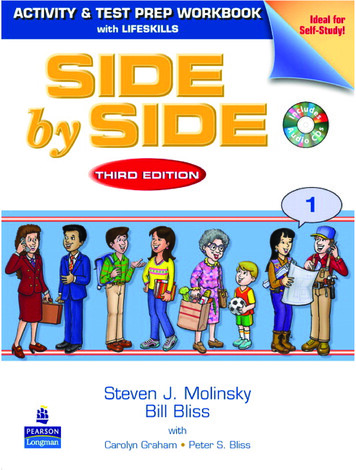
Transcription
B1 Side 1Limits1. For the function f graphed below, find2. For the function f graphed below, find(a) lim f (x)-(b) lim f (x) (a) lim f (x)-(b) lim f (x) (c) lim f (x)(d) 𝑓(3)(c) lim f (x)(d) 𝑓(2)(e) lim f (x)(f) lim f (x)(e) lim f (x)(f) lim f (x)x 3x 3x - x 3x x 2x 2x - x 2x 3. For the function f graphed below, find4. For the function f graphed below, find(a) lim f (x)-(b) lim f (x) (a) lim f (x)-(b) lim f (x) (c) lim f (x)(d) 𝑓(4)(c) lim f (x)(d) 𝑓(0)(e) lim f (x)(f) lim f (x)(e) lim f (x)(f) lim f (x)x 4x 4x - x 4x 5. For the function f graphed below, find(a) lim- f (x)x -2(b) lim f (x)x -2(c) lim f (x)(d) 𝑓( 2)(e) lim f (x)(f) lim f (x)x -2x - x x 0x 0x - x 0x 6. For the function f graphed below, find(a) lim- f (x)(b) lim f (x)(c) lim f (x)(d) 𝑓 (3)(e) lim f (x)(f) lim f (x)x 3x 3x - x 3x
B1 Side 27. For the function f graphed below, find8. For the function F graphed below, find(a) lim f (x)-(b) lim f (x) (a) lim f (x)-(b) lim f (x) (c) lim f (x)(d) 𝑓( 2)(c) lim f (x)(d) 𝑓(3)(e) lim f (x)(f) lim f (x)(e) lim f (x)(f) lim f (x)x -2x -2x - x -2x x 3x 3x - x 3x 9. For the function f graphed below, find10. For the function f graphed below, find(a) lim- f (x)(b) lim f (x)(a) lim- f (x)(b) lim f (x)(c) lim f (x)(d) 𝑓(0)(c) lim f (x)(d) 𝑓(0)(e) lim f (x)(f) lim f (x)(e) lim f (x)(f) lim f (x)x 0x 0x - x 0x 11. Consider the function g in thefollowinggraph. For what values of 𝑥0 doeslim g(x) exist?x x0x 0x 0x - x 0x 12. Consider the function f graphed below.For what values of 𝑥0 does lim f (x)x x0exist?
B2Trig limitsFind the following limits. For each problem, you will need to manipulate the given expressionso that you can use1.2.3.4.5.6.7.8.9.10.(hint: rewrite assin 5xxsin 3xx)
B3 Side 1A.1. lim5𝑥 11𝑥 2 (3 2𝑥)43. lim (2𝑥 4𝑥 2 𝑥)4. lim (𝑥 16 𝑥 2 )𝑥 25. lim2𝑥 2 𝑥 6𝑥 3/29. lim 4𝑥 2 4𝑥 33𝑥 2 𝑥 1010. lim𝑥 215(1/𝑥) ( )𝑥 53 𝑥𝑥 4 167. lim 𝑥 2 𝑥 2𝑥 2 𝑥 2𝑥 2111. lim𝑥 5𝑥 3(2 ℎ) 3 2 3ℎ8𝑥 3 1𝑥 1/2 2𝑥 1 𝑥 2𝑥 2 𝑥 213. lim 3 𝑥 ℎ 0𝑥 46. lim𝑥 0 𝑥17. lim6 7𝑥2. lim𝑥 3 𝑥 1(𝑎 ℎ)4 𝑎414. lim15. lim18. lim(𝑥 2 3)019. lim ℎℎ 0𝑥 5𝑥 2 𝑥 2 2 𝑥18. lim 𝑥 3𝑥 312. lim 5𝑥 23𝑥 316. lim 𝑥 3 27𝑥 320. lim𝑥 1𝑥 1 (𝑥 1)2Find the limits where [ ] denotes the greatest integer function.21. lim ([𝑥] 𝑥 2 )22. lim ([𝑥] 𝑥 2 )𝑥 3𝑥 323. Prove, directly from the definition of limit, that lim(5𝑥 21) 9.𝑥 624. Suppose f(x) 1 if x is rational and f(x) -1 if x is irrational. Prove that lim 𝑓(𝑥) does not𝑥 𝑎exist for any real number a.Find all numbers for which f is continuous.325. 𝑓(𝑥) 2𝑥 4 𝑥 1 26. 𝑓(𝑥) (2 𝑥)(3 𝑥)27. 𝑓(𝑥) 9 𝑥 228. 𝑓(𝑥) 𝑥 4 16 𝑥𝑥 2 1Find the discontinuities of 𝑓.29. 𝑓(𝑥) 𝑥 2 16 𝑥 2 1630. 𝑓(𝑥) 1𝑥 2 1631. 𝑓(𝑥) 𝑥 2 𝑥 2𝑥 2 2𝑥32. 𝑓(𝑥) 𝑥 2𝑥 3 833. If 𝑓(𝑥) 1/𝑥 2 , verify the Intermediate Value Theorem (2.37) for 𝑓 on [2, 3].34. Prove that 𝑥 5 7𝑥 2 3𝑥 5 0 has a root between -2 and -1.
B3 Side 2B.Find the limit (if it exists).1. lim (4 𝑥)2. lim (4𝑥 3/2 𝑥 3)3. lim ( 𝑥 6 𝑥)4. lim ( 5 2𝑥 𝑥 2 )5. lim ( 𝑥 2 25 3)6. lim 𝑥 9 𝑥 2𝑥 0𝑥 0𝑥 5/2𝑥 6𝑥 3𝑥 57. lim 𝑥 3 𝑥 3 8.𝑥 311. lim 𝑥 5lim𝑥 10 𝑥 10 𝑥 10 9. lim (𝑥 3)2𝑥 3𝑥 312. lim 𝑥 314. lim 𝜋 𝑥 𝑥 𝜋𝑥 7𝑥 10 (𝑥 10)2 𝑥 2 16𝑥 4𝑥 4𝑥 7𝑥 10lim41 2𝑥 1013. lim 𝑥 7 10.𝑥 𝜋115. lim 𝑥𝑥 0116. lim 𝑥 8𝑥 8For each 𝑓, find lim 𝑓(𝑥), lim 𝑓(𝑥), and sketch the graph of 𝑓.𝑥 23𝑥 𝑖𝑓 𝑥 217. 𝑓(𝑥) { 2𝑥 𝑖𝑓 𝑥 2𝑥 2𝑥3𝑖𝑓 𝑥 218. 𝑓(𝑥) {4 2𝑥 𝑖𝑓 𝑥 2
B4 Side 1ContinuityDefinition #1A function 𝑓(𝑥) is continuous at 𝑥 𝑎 iff all of the following conditions are met:1. 𝑓(𝑎) 𝑖𝑠 𝑑𝑒𝑓𝑖𝑛𝑒𝑑2. lim 𝑓(𝑥) 𝐿, 𝐿 𝑎 𝑟𝑒𝑎𝑙 𝑛𝑢𝑚𝑏𝑒𝑟𝑥 𝑎3. 𝑓(𝑎) 𝐿Definition #2A function 𝑓 is continuous on the interval [𝑎, 𝑏] if 𝑓 is continuous at every number in theinterval (𝑎, 𝑏) and if the two one sided limits at a and b, respectively, agree with 𝑓(𝑎) and𝑓(𝑏), respectively.Investigate the continuity of each function for the given value of a. Justify your answers usingthe above definitions.1 𝑥 𝑥 21. 𝑓(𝑥) { 2𝑥 2𝑥 𝑥 2𝑎 2 𝑥, 𝑥 1𝑥 117. 𝑓(𝑥) {1,𝑥,𝑥 1𝑎 1 2𝑥 3,19. 𝑓(𝑥) { 2𝑥1𝑥 1,20. 𝑓(𝑥) { 23 𝑥3 𝑥,21. 𝑓(𝑥) { 2𝑥 1𝑥 1𝑥 1𝑥 2𝑥 2𝑥 2𝑥 2 𝑥 2 3,22. 𝑓(𝑥) {𝑥 5,𝑥 0𝑥 018. 𝑓(𝑥) 𝑎 1𝑎 2𝑎 2𝑎 0⟦𝑥⟧2 𝑥
B4 Side 223. 𝑓(𝑥) 𝑥 1 𝑥 1𝑎 124. 𝑓(𝑥) 25. 𝑓(𝑥) ⟦𝑥 1⟧ 4 𝑥 4 𝑥𝑎 426. 𝑓(𝑥) 𝑥 ⟦𝑥⟧27. ℎ(𝑥) 𝑓(𝑔(𝑥)),𝑓(𝑥) 28. ℎ(𝑥) 𝑓(𝑔(𝑥)),𝑓(𝑥) 1 𝑥1,𝑔(𝑥) 𝑥 1, 𝑥 1𝑔(𝑥) 𝑥 2 5,𝑥 139. Determine the constant 𝑎 such that the function is continuous on the entire real line.𝑓(𝑥) {𝑥3,𝑥 2𝑎𝑥 2 , 𝑥 240. Determine the constants 𝑎 and 𝑏 such that the function is continuous on the entire real line.2,𝑓(𝑥) { 𝑎𝑥 𝑏, 2,𝑥 1 1 𝑥 3𝑥 3In Exercises 41 and 42, use a graphing utility to graph the function. Then use the graph todetermine any x-values at which the function is not continuous.41. ℎ(𝑥) 1𝑥 2 𝑥 22𝑥 4,42. 𝑓(𝑥) { 2𝑥 2𝑥,𝑥 3𝑥 3In Exercises 43-46, find the interval(s) on which the function is continuous.43. 𝑓(𝑥) 𝑥,𝑥 2 144. 𝑓(𝑥) 𝑥 𝑥 3
B5 topDifference QuotientFind the difference quotientf ( x) f (a)f (x h) - f (x)orfor the following.x ah1. f ( x) 2x 2 - 3x 42. f ( x) x 3 2x -113. f ( x) 1x -44. f ( x) 5. f ( x) xx 16. f x 3x - 4( x 2)2()B5 bottomIntermediate Value TheoremFor each of the following problems:A) Decide whether or not the Intermediate Value Theorem can be applied to the givenfunction, value and interval. Justify your decision carefully.B) When this theorem applies, state carefully what it concludes.C) Finally, find all values c in the given interval, such that 𝑓(𝑐) 𝑘.1. 𝑓(𝑥) 𝑥 2 2𝑥 1; 𝑘 4, [ 3, 2]2. 𝑓(𝑥) 𝑥 2 𝑥 1 ; 𝑘 7, [ 2, 3]3. 𝑓(𝑥) 10𝑥 2 1; 𝑘 8, [0, 1]4. 𝑓(𝑥) 𝑥 3 ; 𝑘 2, [ 3, 6]15. 𝑓(𝑥) 2𝑥 1 ; 𝑘 0.5, [1, 2]6. 𝑓(𝑥) 𝑥 2 8𝑥; 𝑘 6, [1, 3]
B6 side 11. In each part, find the limit by inspection.(a) lim ( 3)(b) lim ( 2ℎ)𝑥 ℎ 2. In each part, find the stated limit of 𝑓(𝑥) 𝑥/ 𝑥 by inspection.(a) lim 𝑓(𝑥)(b) lim 𝑓(𝑥)𝑥 𝑥 3. Given thatlim 𝑓(𝑥) 3,lim 𝑔(𝑥) 5,𝑥 lim ℎ(𝑥) 0𝑥 𝑥 find the limits that exist. If the limit does not exist, explain why.(a) lim [𝑓(𝑥) 3𝑔(𝑥)](b) lim [ℎ(𝑥) 4𝑔(𝑥) 1](c) lim [𝑓(𝑥)𝑔(𝑥)](d) lim [𝑔(𝑥)]2(e) lim 3 5 𝑓(𝑥)(f) lim𝑥 𝑥 𝑥 3ℎ(𝑥) 46𝑓(𝑥)(h) lim𝑥2𝑥 3𝑥 𝑔(𝑥)𝑥 (g) lim𝑥 𝑥 5𝑓(𝑥) 3𝑔(𝑥)4. Given thatlim 𝑓(𝑥) 7,𝑥 lim 𝑔(𝑥) 6𝑥 find the limits that exist. If the limit does not exist, explain why.(a) lim [2𝑓(𝑥) 𝑔(𝑥)](b) lim [6𝑓(𝑥) 7𝑔(𝑥)](c) lim [𝑥 2 𝑔(𝑥)](d) lim [𝑥 2 𝑔(𝑥)]𝑥 𝑥 𝑥 3(e) lim 𝑓(𝑥)𝑔(𝑥)(f) lim𝑥 𝑔(𝑥)𝑥𝑔(𝑥)𝑥 𝑓(𝑥)𝑥 (g) lim [𝑓(𝑥) 𝑥 ](h) lim𝑥𝑓(𝑥)𝑥 (2𝑥 3)𝑔(𝑥)In Exercises 5-28, find the limits.15. lim (3 𝑥)6. lim (5 𝑥)7. lim (1 2𝑥 3𝑥 5 )8. lim (2𝑥 3 100𝑥 5)9. lim 𝑥10. lim 5 𝑥𝑥 𝑥 𝑥 𝑥 𝑥 𝑥
B6 Side 211. lim3𝑥 112. lim𝑥 2𝑥 2 3𝑥 2𝑥 5313. lim𝑥 𝑥 23𝑥 19. lim𝑥 21. lim𝑥 𝑥 1216. lim𝑥 2 2𝑥 131 8𝑥 2𝑠 5𝑥 2 220. lim𝑥 3𝑥 2 𝑦22. lim 3𝑥 4 𝑥24. lim 5𝑥 2 2𝑥 32 𝑦 3𝑥 4 𝑥𝑥 𝑥 2 87 6𝑥 526. lim5 2𝑡 3𝑡 𝑡 2 1𝑥 𝑥 327. lim2𝑠7 1𝑦 7 6𝑦 2𝑥 𝑥 2 825. lim3𝑠7 4𝑠518. lim 𝑦 7 6𝑦 223. lim5𝑥 2 7𝑥 3𝑥 2 𝑥2 3𝑥 5𝑥 217. lim 114. lim𝑦 𝑦 415. lim5𝑥 2 4𝑥6 𝑡 328. lim𝑡 7𝑡 3 3𝑥 4𝑥 3𝑥 1 𝑥2 7𝑥 329. Let𝑓(𝑥) {2𝑥 2 5,3 5𝑥 31 4𝑥 𝑥 3Find(a) lim 𝑓(𝑥)𝑥 ,𝑥 0𝑥 0(b) lim 𝑓(𝑥)𝑥 30. Let2 3𝑡,5𝑡 2 6𝑔(𝑡) 36𝑡 2 100,{5 𝑡Find(a) lim 𝑔(𝑡)𝑡 𝑡 1,000,000𝑡 1,000,000(b) lim 𝑔(𝑡)𝑡
B6 Side 3In Exercises 31-34, find the limits.31. lim ( 𝑥 2 3 – 𝑥)𝑥 32. lim ( 𝑥 2 3𝑥 – 𝑥)𝑥 33. lim ( 𝑥 2 𝑎𝑥 – 𝑥)𝑥 34. lim ( 𝑥 2 𝑎𝑥 – 𝑥 2 𝑏𝑥)𝑥 35. Discuss the limits of 𝑝(𝑥) (1 𝑥)𝑛 as 𝑥 and 𝑥 for positive integer valuesof 𝑛.36. Let 𝑝(𝑥) (1 𝑥)𝑛 and 𝑞(𝑥) (1 𝑥)𝑚 . Discuss the limits of 𝑝(𝑥)/𝑥 𝑚 as 𝑥 and𝑥 for positive integer values of 𝑚 and 𝑛.37. Let 𝑝(𝑥) be a polynomial of degree 𝑛. Discuss the limits of 𝑝(𝑥)/𝑥 𝑚 as 𝑥 and 𝑥 for positive integer values of 𝑚.38. In each part, find examples of polynomials 𝑝(𝑥) and 𝑞(𝑥) that satisfy the stated conditionand such that 𝑝(𝑥) and 𝑞(𝑥) as 𝑥 .(a) lim𝑝(𝑥)𝑥 𝑞(𝑥)(c) lim𝑝(𝑥)𝑥 𝑞(𝑥)𝑝(𝑥) 1(b) lim (d) lim [𝑝(𝑥) 𝑞(𝑥)] 339. Assuming that 𝑚 and 𝑛 are positive integers, find2 3𝑥 𝑛lim𝑥 1 𝑥 𝑚𝑥 𝑞(𝑥)𝑥 0
B7Definition of DerivativeShow your work on a separate piece of paper.Use the form:to find the derivative of each of the following:2. f ( x ) 1. f ( x) x 2 2()4. f ( x ) 3. f x 1 - xUse the form1x1x 12to find the value of each derivative at the given point.5. f ( x ) x 2 at (2,4)6. f ( x) 2x - x 2 at (1,1)Using either of the forms above, find the slope of the tangent to y f ( x) at the given point.Then write the equation of the line tangent to y f ( x) at the given point.7. f ( x) x 2 x 2 at (1, 4)B8()8. f x x at (9, 3)DifferentiabilityFor which value or values of x does g fail to have a derivative. You may use your graphingcalculator to investigate the graphs. If you do, draw a sketch of the graph on your paper.9. g ( x ) x - 210. g ( x ) x - 211. g ( x ) 9 - x 212. g ( x ) 4x - x 2Which of the following are differentiable at x 0? For those that are, find f f (0). You may useyour graphing calculator.13. f ( x ) x x()15. f x x14. f ( x ) x 2(16. f ( x ) x 1 - x)
B9 Side 11) lim2𝑥 3𝑥 5𝑥 7Limits Practice16) lim 𝑥 2 1 𝑥 1𝑥 𝑥 3 𝑥 2 𝑥 73) lim3𝑥 73𝑥 2 6𝑥7𝑥 12𝑥 4𝑥 𝑥 3 17) lim𝑥 8) lim2𝑥 4 20) lim21) lim 3𝑥 4 16𝑥 2 𝑥 01 𝑥 2𝑥 15𝑥11) lim ( 3𝑥 2)(6𝑥 1)𝑥 2𝑥 1𝑥 2 𝑥 12𝑥 123) lim 𝑥 25) lim11𝑥 𝑥26) lim 𝑥𝑥7𝑥 4 (𝑥 2)3 8𝑥 0𝑥 27) lim 𝑓(𝑥) 28) lim 𝑓(𝑥) 14) lim 𝑥 3 𝑥 32𝑥 1𝑥 3𝑥 𝑥𝑥2 𝑥22) lim24) lim 10) lim (5 𝑥 2 )(2𝑥 1) 1 𝑥 2 45𝑥 3 8𝑥 2 𝑥 6 31𝑥 1 𝑥 1𝑥 2 3𝑥 2𝑥 2𝑥 𝑥 3 4𝑥 113) lim𝑥 5𝑥 510𝑥 5 10𝑥 412) lim𝑥 2 3𝑥 1019) lim 𝑥 49) lim 𝑥 2 118) lim 𝑥 3 2𝑥 2 𝑥 4 7𝑥 3 7𝑥 2 9𝑥 𝑥 2 3𝑥 2𝑥 1 𝑥 𝑥 3 36) lim17) lim𝑥 2𝑥 4𝑥 85) lim 𝑥 𝑥 24) lim𝑥 3𝑥 1 2𝑥 3 72) lim115) lim 𝑥 3 𝑥 1𝑥 0
B9 Side 229) lim 𝑓(𝑥) 38) lim 𝑔(𝑥) 30) lim 𝑓(𝑥) 39) lim 𝑔(𝑥) 31) lim 𝑓(𝑥) 40) lim 𝑔(𝑥) 32) lim 𝑓(𝑥) 41) lim 𝑔(𝑥) 33) lim 𝑓(𝑥) 42) lim 𝑔(𝑥) 34) lim 𝑓(𝑥) 43) lim 𝑔(𝑥) 35) lim 𝑥 1 44) lim 𝑔(𝑥) 𝑥 1𝑥 1𝑥 2𝑥 1𝑥 1𝑥 2𝑥 0𝑥 0𝑥 1𝑥 1𝑥 3𝑥 0𝑥 1𝑥 336) lim𝑥 0(4 𝑥)2 16𝑥 37) lim(𝑥 2)1998 𝑥 345) lim 2𝑥 𝑥 346) lim1(2𝑥 1) 𝑥 247) lim 3𝑥 2 (2𝑥 1) 𝑥 148. lim (3𝑥 1) 𝑥 1
B10 Side 1A1. 𝑃(1, 1) is a point on the graph of 𝑦 𝑥 3 . Find the slope of 𝑃𝑄 if 𝑄 is:a. (2, 8)b. (1.5, 3.375)c. (1.1, 1.331)d. If 𝑓(𝑥) 𝑥 3 , find 𝑓 ′ (𝑥) and 𝑓 ′ (1).112. 𝑃(2, 2) is a point on the graph of 𝑦 𝑥. Find the slope of ̅̅̅̅𝑃𝑄 if 𝑄 is:a. (3, 𝑓(3))b. (2.5, 𝑓(2.5))c. (2.1, 𝑓(2.1))1d. If 𝑓(𝑥) 𝑥, find 𝑓 ′ (𝑥) and 𝑓 ′ (2).Find the derivative of the given function. Express the derivative without using fractional or negativeexponents.3. 𝑓(𝑥) 2𝑥 57. 𝑓(𝑥) 38. 𝑔(𝑥) 𝑥211. 𝑔(𝑥) 4. 𝑓(𝑥) 3𝑥 67𝑥 2 5𝑥 3 24 𝑥15. 𝑓(𝑥) 2𝑥 36. 𝑓(𝑥) 8𝑥 3/49. 𝑓(𝑥) 5𝑥10. 𝑓(𝑥) 4𝑥3 312. 𝑓(𝑥) 𝑥2 𝑥5𝑥214𝑥 4 𝜋Find the slope of each curve at the given point P.𝑥4113. 𝑦 𝑥 3 ; 𝑃( 1, 1)14. 𝑦 15. 𝑦 3𝑥 2 2𝑥 1; 𝑃(0, 1)16. 𝑦 2 𝑥; 𝑃(9, 6)17. 𝑦 8𝑥 4 7𝑥 2 5𝑥 6; 𝑃( 1, 2)18. 𝑦 𝑥 3 5𝑥 2 4𝑥 2; 𝑃(2, 2)2; 𝑃( 1, 2)B19. 𝑦 2𝑥 4𝑥23; 𝑃(2, 0)20. 𝑦 𝑥; 𝑃( 1, 1)21. a. If 𝑓(𝑥) 𝑎𝑥 2 𝑏𝑥 𝑐 where 𝑎 0, find 𝑓′(𝑥).𝑏b. Visual Thinking Evaluate 𝑓′( 2𝑎) and explain what the result says about the tangent to theparabola 𝑦 𝑓(𝑥) at the vertex22. Visual Thinking Give a geometric argument to explain why two functions whose rules differ only by aconstant have the same derivative.
B10 Side 2Find an equation of the line tangent to the given curve at the given point P.23. 𝑦 𝑥 3 ; 𝑃( 2, 8)24. 𝑦 3𝑥 2 5𝑥; 𝑃(2, 2)125. 𝑦 𝑥 2 ; 𝑃( 1, 1)26. 𝑦 13 𝑥1; 𝑃(8, 2)27. a. Sketch the graph of the function 𝑓(𝑥) 6𝑥 2 𝑥 3b. For what values of x does 𝑓 ′ (𝑥) 0?c. On your graph of 𝑓(𝑥), indicate the two points where 𝑓 ′ (𝑥) 0.28. Repeat Exercise 27 using the function 𝑓(𝑥) 𝑥 3 9𝑥.29. a. If 𝑓(𝑥) 𝑥 2/3 , find 𝑓′(𝑥).b. For what values of x is 𝑓′(𝑥) undefiend?c. Sketch the graph of 𝑓(𝑥). (If you use a computer on graphing calculator, you may need toenter the rule for the function as (𝑥 2 )1/3 to obtain the complete graph. ) Explain how the graph of𝑓(𝑥) supports the result of part (b).30. Repeat Exercise 29 using the function 𝑓(𝑥) 𝑥1/3 .In Exercises 31-36, find a function that has the given derivative.31. 𝑓 ′ (𝑥) 4𝑥 332. 𝑓 ′ (𝑥) 5𝑥 433. 𝑔′ (𝑥) 3𝑥 534. 𝑔′ (𝑥) 𝑥 735. ℎ′ (𝑥) 3 𝑥36. ℎ′ (𝑥) 𝑥3C37.a. Use the binomial theorem (page 591) to write the first three terms and the last term in the expansionof (𝑥 ℎ)𝑛 .b. Use part (a) and the definition of 𝑓 ′ (𝑥) to prove Theorem 2 on page 760 for positive integral values of𝑛.(Note: The binomial theorem can be generalized to apply to any nonzero real number 𝑛. This form of thebinomial theorem can then be used to give a general proof of Theorem 2.)38. Prove Theorem 3 on page 760. (Hint: Use the definition of 𝑓 ′ (𝑥).)39. Prove Theorem 4 on page 760. (Hint: Use the definition of 𝑓 ′ (𝑥).)
B11Sketching PolynomialsFind the local extrema of f . Describe the intervals in which f is increasing or decreasing and sketch thegraph of f .1. f ( x) 5 7 x 4 x 22. f ( x) 6 x2 9 x 53. f ( x) 2 x 3 x 2 20x 14. f ( x) x3 x2 40 x 85. f ( x) x 4 8x 2 16. f ( x) x3 3x2 3x 77. f ( x) x 4/3 4 x1/38. f ( x) x2/3 (8 x)9. f ( x) x 2 3 x 2 410. f ( x) x 4 x 211. f ( x) x 2/3 ( x 7)2 212. f ( x) 4 x3 3x 413. f ( x) x3 (3 / x)14. f ( x) 8 3 x 2 2 x 115. f ( x) 10 x3 ( x 1)216. f ( x) ( x2 10 x)4Find the local extrema of f .17. f ( x) 3 x3 9 x18. f ( x) x 2 / x 719. f ( x) ( x 2)3 ( x 1)420. f ( x) x2 ( x 5)421. f ( x) (2 x 5) / ( x 3)22. f ( x) ( x2 3) / ( x 1)23-26 Find the absolute maximum and minimum values on each of the given intervals:23. f ( x) 5 7 x 4 x 2(a) [-1, 1](b)[-4, 2](c)[0, 5]25. f ( x) 2 x 3 x 2 20x 1(a) [-1, 1] (b)[-4, 2](c)[0, 5]24. f ( x) 6 x2 9 x 5(a) [-1, 1] (b)[-4, 2](c)[0, 5]26. f ( x) x3 x2 40 x 8(a) [-1, 1] (b)[-4, 2](c)[0, 5]Sketch the graph of a differentiable function f which satisfies the given conditions.27. f '( 5) 0 ; f '(0) 0 ; f '(5) 0 ; f '( x) 0 If x 5 ; f '( x) 0 if 0 x 528. f '(a) 0 for a 1, 2,3, 4,5 and f '( x) 0for all other values of x.Find the local extrema of f . Describe the intervals in which f ' is increasing or decreasing. Sketch thegraph of f and study the variation of the slope of the tangent line as x increases through the domain off.29. f ( x) x 4 6 x 230. f ( x) 4 x3 3x 431. If f ( x) ax3 bx2 cx d , determineValues for a, b, c, and d such that f has a localMaximum 2 at x -1 and a local minimum -1 atx 1.32. If f ( x) ax4 bx3 cx2 dx e , determine values of a, b, c, d and e such that f has alocal maximum 2 at x 0, and a local minimum-14 at x -2 and x 2, respectively.
B12 Side 1ConcavityUse the Second Derivative Test (whenever applicable) to find the local extrema of f . Discuss concavity,find x-coordinates of points of inflection, and sketch the graph of f .1. f ( x) x3 2 x 2 x 12. f ( x) x3 10 x x 25x 503. f ( x) 3x 4 4 x3 64. f ( x) 8x 2 2 x 45. f ( x) 2 x6 6 x 46. f ( x) 3x5 5x37. f ( x) ( x 2 1)28. f ( x) x (16 / x)10. f ( x) ( x 4) / x9. f ( x) 5 x 111. f ( x) x (27 / x )12. f ( x) x2/3 (1 x)13. f ( x) x / ( x 2 1)14. f ( x) x 2 / ( x 2 1)15. f ( x) 3 x 2 (3x 10)16. f ( x) x 4 4 x3 1017. f ( x) 8x1/3 x 4/318. f ( x) x 4 x 222Sketch the graph of a continuous function f which satisfies all of the started conditions.19. f (0) 1 ; f (2) 3 ;20. f (0) 4 ; f (2) 2 ; f (5) 6f '(0) f '(2) 0 ;f '(0) f '(2) 0f '( x) 0 if x 1 1 ;f '( x) 0 if x 1 1 ;f '( x) 0 if x 1 1 ;f '( x) 0 if x 1 1 ;f ''( x) 0 if x 1;f ''( x) 0 if x 1 or if x 4 1 ;f ''( x) 0 if x 1f ''( x) 0 if x 2 1 or if x 521. f (0) 2 ; f (2) f ( 2) 1 ;f '(0) 0 ;f '( x) 0 if x 0 ;f '( x) 0 if x 0 ;22. f (1) 4 ;f '( x) 0 if x 1;f '( x) 0 if x 1 ;f ''( x) 0 for all x 1 .f ''( x) 0 if x 2 ;f ''( x) 0 if x 2 .23. f ( 2) f (6) 2 ; f (0) f (4) 0 ;f (2) f (8) 3 ;f ' is undefined at 2 and 6;(10, ) ;f '(0) 1 ;f '( x) 0 throughout ( , 2) and (6, ) ;24. f (0) 2 ; f (2) 1 ; f (4) f (10) 0 ; f (6) 4f '(2) f '(6) 0 ;f '( x) 0 for x in ( , 2) , (2, 4) , (4, 6) , andf '( x) 0 throughout (6,10) ;f '(4) and f '(10) do not exist;f '( x) 0 if x 4 2 ;f ''( x) 0 throughout ( , 2) , (4,10) , and(10, ) ;f ''( x) 0 throughout ( , 0) , (4, 6) , (6, ) ;f ''( x) 0 throughout (0, 2) and (2, 4) .f ''( x) 0 throughout (2, 4)
B12 Side 225. If n is an odd integer, then f (n) 1 and f '(n) 0 ; if n is an even integer, then f (n) 0 and f '(n)does not exist; if n is any integer then(a) f '( x) 0 whenever 2n x 2n 1(b) f '( x) 0 whenever 2n 1 x 2n(c) f ''( x) x whenever 2n x 2n 226. f ( x) x if x -1, 2, 4 or 8;f '( x) 0 if x -1, 4, 6 or 8;f '( x) 0 throughout ( , 1) , (4, 6), and (8, ) ;f '( x) 0 throughout (-1, 4) and (6, 8);f ''( x) 0 throughout ( ( , 0) , (2, 3), and (5, 7);f ''( x) 0 throughout (0, 2), (3, 5) and (7, ) .27. Prove that the graph of a quadratic function has no points of inflection. State conditions under whichthe graph is always (a) concave upward; (b)concave downward. Illustrate with sketches.28. Prove that the graph of a polynomial function of degree 3 has exactly one point of inflection.Illustrate this fact with sketches.29. Prove that the graph of a polynomial function of degree n 2 has at most n-2 points of inflection.30. If f ( x) xn , where n 1, prove that the graph of f has either one or no points of inflection,according to whether n is odd or even. Illustrate with sketches.
B13Justifying answers1. f (x ) 2 x 4 4 x3 Find all extrema. Justifya) using the first derivative test.b) using the second derivative test2. f (x ) 2 x6 6 x 4 Find all extrema. Justifya) using the first derivative testb) using the second derivative test.3. Find the absolute maximum and absolute minimum of f (x ) 2 x6 6 x 4 over the interval [-2, 1].Justify your answer using candidates test.
B14Product & Quotient Rules6. Differentiate the function: h(x) (x – 2) (2x 3)21. Find the derivative of y (x2 1) (x3 1) in two ways: by using the Product Rule and by performingthe multiplication first. Do your answers agree?22. Find the derivative of the function 𝐹(𝑥) 𝑥 3𝑥 𝑥 𝑥in two ways: by using the Quotient Rule and bysimplifying first. Show that your answers are equivalent. Which method did you prefer?23 - 42 Differentiate.1323. V (x) (2x3 3) (x4 – 2x)25. F (y) ( 2 4 ) (𝑦 5𝑦 3 )26. 𝑦 𝑥(𝑥 1)𝑥 130. 𝑦 𝑥 3 𝑥 234. 𝑔(𝑡) 𝑡 𝑡4𝑡 3𝑐𝑥38. 𝑦 1 𝑐𝑥𝑦2𝑡𝑦28. 𝑓(𝑡) 4 𝑡 2𝑡32. 𝑦 (𝑡 1)2𝐵𝐶36. 𝑦 𝐴 𝑥 𝑥 240.𝑦 𝑎𝑥 𝑏𝑢6 2𝑢3 5𝑢242. 𝑓(𝑥) 𝑐𝑥 𝑑2𝑥49. Find an equation of the tangent line to the curve at the given point. 𝑦 𝑥 1 , (1,1)3𝑥 155. Find equations of the tangent line and normal line to the curve 𝑦 𝑥 2 1 at the point (1,2)64. Find ℎ′ (2), given that 𝑓(2) 3, 𝑔(2) 4, 𝑓 ′ (2) 2, 𝑎𝑛𝑑 𝑔′ (2) 7.(a) ℎ(𝑥) 5𝑓(𝑥) 4𝑔(𝑥)𝑓(𝑥)(c) ℎ(𝑥) 𝑔(𝑥)(b) ℎ(𝑥) 𝑓(𝑥)𝑔(𝑥)𝑔(𝑥)(d) ℎ(𝑥) 1 𝑓(𝑥)65. If 𝑓(𝑥) 𝑥 𝑔(𝑥), where 𝑔(4) 8 and 𝑔′(4) 7, find 𝑓 ′ (4).𝑑66. If ℎ(2) 4 and ℎ′ (2) 3, find 𝑑𝑥 (ℎ(𝑥)) x 2𝑥68. Let 𝑃(𝑥) 𝐹(𝑥)𝐺(𝑥) and 𝑄(𝑥) 𝐹(𝑥)/𝐺(𝑥), where F and G are the functions whose graphs areshown. (a) Find P (2) and (b) Find Q (7 )69. If 𝑔 is a differentiable function find an expression for the derivative of each of the followingfunctions.g ( x)x(a) 𝑦 𝑥𝑔(𝑥)(b) y (c) y xg ( x)3271. Find the points on the curve y 2 x 3x 12 x 1 where the tangent is horizontal.72. For what values of x does the graph of f ( x) x3 3x 2 x 3 have a horizontal tangent?74. Find an equation of the tangent line to the curve y x x that is parallel to the line y 1 3x .76. Find equations of the tangent lines to the curve y x 1that are parallel to the line x 2 y 2x 1
B15Review Limits/FunctionsFind each Limit1. lim2 x 2 5x 3x 3 x 2 x 122. lim 3x 2 2 1 5 4. lim 2x 2 x 1 x 5. lim3 sin 4 xx 0 sin 3 xx 5x 3x 3x 3(10. lim 5 2 x x 2 )11. limx 2 x 2 13. f (x ) 2 4 x 2 6. limx 18. lim(x 2)2x 2 8x 3 1x 1 2 x 125 x 11x 3x 27. limsin xx 0 3 x 2 2 x3. lim9. lim( 1 x ) ( 15 )x 5x 5x 1012. lim 3x 2 10x 3515x 3lim f ( x ) if x 1if x 1Find lim f ( x ) if x 1lim f ( x ) x 1 x 1 x 114. Find the Domain/intercepts/asymptotes and grapha) f (x ) (2 x )(3 x )b) f (x ) 6x 2 2x39 x2c) f (x ) x 2x 2x 8215. Use the definition of continuity to determine whether f is cont or discont at x a x 2 1 a) f (x ) 1 x 1 k 2 x16. If f (x ) 3kx 2if x 1if x 1 at a 1if x 1if x 1if x 1b) f (x ) 3x2x 1at a 8find the value of k such that f ( x ) is continuous.
B16Review of Derivatives1. Use the definition of derivative to find f’(x).a) f (x ) 3x 1b) f (x ) x 2 3x2. Use the definition of derivative to find the slope of the tangent line to f (x ) 1at x 3 .2x 3Use the power rule now3. Find the equation of the tangent line to f (x ) 2 x 3 x 2 5x at x 2 .14. Find the equation of the line tangent to f (x ) x at x 1 .x5. Find the points on f ( x ) where the tangent line is horizontal.a) f (x ) 3x 2 2 x 8b) f (x ) 3x 4 2 x 2 16. Determine whether f has a vertical tangent at (0, 0).a) f ( x ) x 3b) f ( x ) 5x 2137. Find f ( x )3a) f (x ) 3x 3 5 x 828. If f ( x ) 5 x 3 7 x 3 4b) f (x ) x 4 x 2 2x4 5 x 6 , find f ( x ), f (x ), f (x )x2c) f (x ) e 2
B17 Side 1In Exercises 1-28, evaluate the given limit or state that it does not exist.A3𝑥 51. lim𝑥 3𝑥 2 5𝑥 4𝑥 98𝑥 2 7𝑥 53. lim𝑥 5. lim7. lim𝑥 7𝑥 3 8𝑥 2(𝑥 2 1)(𝑥 2 1)6. lim2𝑥 4𝑥 2 18. lim𝑥 3𝑥 410. lim 𝑥 2 𝑥 12𝑥 2 2𝑥 4𝑥 02𝑥 2 6𝑥𝑥 3𝑥 2 𝑥 611. lim 1𝑥𝑥 2 cos𝑥 2𝑥 2 1𝑥 1 𝑥 19. lim5𝑥 34. lim4𝑥 2 9𝑥 2𝑥 2 7𝑥2. lim𝑥 4𝑥 1𝑥12. lim 𝑥 1𝑥𝑥 1𝑥 42𝑥 613. lim 𝑥 314. lim 𝑥 2 3𝑥𝑥 3𝑥 3𝑥 2 4𝑥 43𝑥 615. lim 𝑥 2 3𝑥 116. lim 2𝑥 4𝑥 2𝑥 2 𝑥 17.a. lim b. lim 18.a. lim 𝑥 2 119.a. lim 𝑥 220.a. lim ⌊𝑥⌋𝑥𝑥 0𝑥 0𝑥 3𝑥 1𝑥 2𝑥 2 4𝑥 3 𝑥 c. lim𝑥 𝑥 𝑥 0 𝑥𝑥 3b. lim 𝑥 2 1𝑥 1𝑥 2b. lim 𝑥 2𝑥 2 4b. lim ⌊𝑥⌋𝑥 3𝑥 3c. lim 𝑥 2 1𝑥 1𝑥 2c. lim 𝑥 2𝑥 2 4c. lim⌊𝑥⌋𝑥 3(Note: ⌊𝑥⌋ is the greatest integer function. See Exercise 21 on page 124).𝑥21. lim22. lim𝑥 0 1 1 𝑥23. lim𝑥 01 𝑥2 1𝑥 26. lim ( 𝑥 2 2𝑥 𝑥)25. lim ( 𝑥 1 - 𝑥)𝑥 27.a. lim28.a. limℎ 0ℎ 0𝑥24. lim ( 4𝑥 2 4𝑥 2𝑥)𝑥2𝑥 02 4 𝑥(1 ℎ)2 1ℎ(1 ℎ)3 1ℎ𝑥 b. limℎ 0b. limℎ 0(2 ℎ)2 4ℎ(2 ℎ)3 8ℎc. limℎ 0c. limℎ 0(𝑥 ℎ)2 𝑥 2ℎ(𝑥 ℎ)3 𝑥3ℎ
B17 Side 2Visual Thinking Use the given function’s graph to evaluate each limita. lim 𝑓(𝑥)b. lim 𝑓(𝑥)c. lim 𝑓(𝑥)d. lim 𝑓(𝑥)𝑥 𝑥 29.𝑥 2𝑥 230.Determine whether each function is continuous. If it is discontinuous, state where any discontinuitiesoccur.2 𝑥 2 𝑖𝑓 𝑥 131. 𝑓(𝑥) {𝑥𝑖𝑓 𝑥 1𝑥 2 4𝑖𝑓 𝑥 233. 𝑓(𝑥) { 𝑥 24𝑖𝑓 𝑥 2𝑥2 132. 𝑓(𝑥) { 2𝑥34. 𝑓(𝑥) 𝑖𝑓 𝑥 0𝑖𝑓 𝑥 0𝑥 11 𝑥Evaluate each limit. The result of part (b) of Exercise 43 may be helpful.44. lim𝜃 0tan 𝜃45. lim𝜃𝜃 0sin 𝜃(Hint: tan 𝜃 cos 𝜃)46. lim𝑡 01 cos 𝑡𝑡2𝜃(Hint: sin 2𝜃 2 sin 𝜃 cos 𝜃)11 cos 𝑡(Hint: Multiply by 1 cos 𝑡)Odd Answers1. ¾15. 023. -1/2 25. 035. -1, 0 37. 1sin 2𝜃3. 25. ½17. 1, -1, does not exist27. 2, 4, 2x39. 047. lim 𝑥 sin 𝑥𝑥 1(Hint: Let 𝑡 𝑥. As 𝑥 , 𝑡 0)7. 29. 5/211. 19. 0, does not exist, does not exist29. 1, 0, , - 31. Cont.33. Cont.41. Does not exist45. 247. 113. - 21. 2
B18 Side 1Miscellaneous Derivatives1. Find k so that the given line is tangent to the graph of f(x) at x 3f (x) x 2 kxa)line y 2x 9b)f (x) kxline y 23 x 4 2. Using the graph to the right,:a) Between which two consecutive points is the average rate of change of f greatest?b) Is the average rate of change of f between A and B greater than or less than theinstantaneous rate of change at B?c) Sketch the tangent line to the graph between C and D such that the slope of thetangent line is equal to the average rate of change of the function between C and D.3.Find each limit. Note the form for each and how it relates to the limit definition of derivative. This should leadyou to a faster way to find the limit for each.a)limh 0h 2 2h2 (3 h ) 7 ) (25 )(c) lim2h 0hb) limh 0 13h13 hx3 x 10d) limx 2x 2
B18 Side 24. Determine whether the piecewise function is differentiable x2 1f (x ) 4 x 3x 2x 25. Determine all values where f (x ) is differentiable?6. Draw a function that satisfies the following:a)f (0 ) 2f (x ) 3 for all xf (0 ) 4, f (0 ) 0b)f (x ) 0 if x 0f (x ) 0 if x 0
B19Graphs of Derivatives Review1. Given the following information, draw a sketch of f(x).f(3) 0, f(6) 0, f(0) 0f l(0) f ‘(2) 0, f ‘(4) 0f ll(x) 0 for x 1 and for x 3f ll(x) 0 for 1 x 32. Given the graph of f(x) below, answer the following questions:a) Where is f(x) increasing?b) What does this tell you about f ( x ) there?c) What is f l(3)?d) At what approximate x-value(s) does f ( x ) 0 ?3. What does each of the following pieces of information tell you about f(x)? (Each is a separatequestion and may refer to different functions)a) f l(x) is positive for 3 x 8b) f ll(x) is negative for -5 x 0c) f l(3) 0d) (this is the result of a 1st derivative test)4. Given the graph of y f (x), graph y f l(x) and y f ll(x)5. Given f (x) x3 4x2 – 11x – 2 find:a) x-interceptsb) y-interceptsc) local max (for c and d, remember to show use of the first derivative test)d) local mine) point(s) of inflectionf) intervals where f(x) is increasing and decreasingg) intervals where f(x) is concave up and concave downh) sketch
B20 ( side 1) Optimization1. The base of a rectangle is on the x-axis and the upper two vertices are on the parabolay 3 x2 , as shown at the left below.a. show that the area of the rectangle is A( x) 6 x 2 x , x 0b. Show that the rectangle has the greatest area when x 1.32. An isosceles trapezoid isinscribed in the parabolay 9 x2 with the base of the trapezoid on the axis, as shown, at the right above.1a. Show that the area of trapezoid is A( x) (9 x 2 )(6 2 x) , x 02b. Show that the trapezoid area has its greatest area when x 1.3. A rectangle has one vertex at the origin, another on the positive x-axis, another on the positive yaxis, and the fourth vertex on the line y 8 2 x . What is the greatest area? What is the greatestarea the rectangle can have?4. A rectangle has area A, where A is constant. The length of the rectangle is x.a. Express the width of the rectangle in terms of A and x.b. Express the perimeter in terms of A and x.c. Find the length and width that minimize the perimeter.d. Of all rectangles with a given area, which one has the least perimeter?5. ManufacturingCongruent squares are cut from the corners of a rectangular sheet of metalthat is 8 cm wide and 15 cm long. The edges are then turned up to make an open box. Let x bethe length of a side of the square cut from each corner.a. Express the volume V of the box as a function of x.b. What value of x maximizes the volume?6. ManufacturingA 1 m by 2 m sheet of metal is cut and folded, as shown, to make a boxwith a top.a. Express the volume V of the box as a function of x.b. What value of x maximizes the volume?7. The graph of y x and y x intersect three times.3a. Find the coordinates of the points of intersection.b. For what positive value of x between the intersection points is the vertical distance betweenthe graphs the greatest?
B20 side 28. ManufacturingA manufacturer produces a metal box with a square base, no top, volumeof 4000 cm3 .a. If the base edges are x cm long, express the height h in terms of x.b. Show that the area of the metal used in the box is given by the functionA( x) x2 16000 x 1 .c. What values of x and h minimize the amount of metal used to make the box.9. BusinessA toy manufacturer can make x toy tool sets a day at a total cost of(300 12 x 0.2 x3/2 ) dollars. Each sets sells for 18 dollars. How many sets should be made eachday in order to maximize the profit?10. Point B is 100 km east of point A. At noon, a truck leaves A and travels north at 60 km/h, while acar leaves B and travels west at 80 k/h.a. Write an expression for the distance d between the car and the truck after t hours of travel.b. When will the distance between the vehicles be a minimum? (Hint: Minimize the square of thedistance)c. What is the minimum distance between the vehicles?11. ManufacturingA box company produces a box with a square base and no top that has a32volume of 8 ft . Material for the bottom costs 6/ ft and the material for the sides costs 3/ft 2 . Find the dimensions of the box that minimize the cost.12. A cone has height 12 and radius 6. A cylinder is inscribed in the cone, as shown.a. Show that h 12-2r for 0 r 6 .b. Find the maximum volume of the inscribed cylinder.13. A cone is inscribed in a sphere with radius 3, as shown at the right.1a. Show that the volume of the cone is V ( x) (9 x 2 )(3 x) for 0 x 33b. Find the maximum volume of the cone.14. Find the maximum volume of cylinder inscribed in a sphere with radius 10.15. BusinessIt costs a construction company (6 0.004x) dollars per mile to operate a truck at xmiles per hour. In addition, it costs 14.40 per hour to pay the driver.a. What is the total cost per mile if the truck is driven at 30mi/h? at 40 mi/h?b. At what speed should the truck be driven to minimize the total cost per mile?c. Why might the company decode to not require the use of the speed found in part (b)?
B21 (side 1) - Optimization1 Find two real numbers whose dif
Find the limits where [ ] denotes the greatest integer function. 21. lim 3 2Ὅ 22. lim 3 2Ὅ 23. Prove, directly from the definition of limit, that lim 6 24. Suppose f(x) 1 if x is rational and f(x) -1 if x is irrational. Prove that lim ὌᑦὍ does not exist for any real number a.
